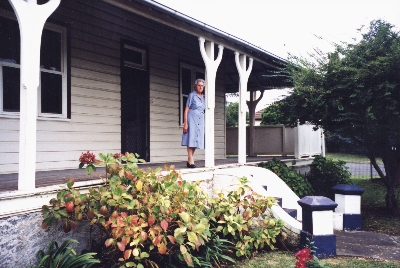Quilt No.732HV - Helen Varoxis
2370 x 1550mm and 2230 x 800mm
The 2 parts of this quilt were made in Cessnock NSW c.1960 by Helen Varoxis. It is still owned by Helen and is still used in winter.
"A Cessnock Quilt
Although this quilt was made in Cessnock, its origins are really in the NSW country town of Cootamundra where Helen Varoxis was born in 1916, and where, as a young woman, she began sewing and making quilts!
Helen's parents, Minas and Maria Coombes came to Australia from the small Greek island of Kythera in 1911, part of the pre-WW11 Greek migration which is now being recognised as an important part of Australia's history. They settled in Cootamundra where their children Kate, Jim, Helen and Ourania were born. Helen worked for several years in their family business, the 'Popular Cafe', after attending Cootamundra Intermediate High School. As with so many Greek Australian women of her generation, Helen's upbringing was as Greek as her parents were able to make it; despite the isolation of the small country town, Greek language and customs were strongly taught.
Among the few other Greeks in Cootamundra were Socrati and Maria Behlevanas and Socrati's close friend Ignatios (Tom) Varoxis; both from the same village of Aghia Paraskevi, on the Greek island of Mytilini (Lesvos). It was Socrati who went to Helen's father on behalf on his friend to ask permission for Helen to marry Tom. They married in 1940, with Socrati as their 'koumbaro' (best man), and with the traditional Greek Orthodox wedding ceremony being conducted, in the local Anglican church, by a priest from Sydney.
Helen and Tom worked hard in their 'White Rose Café'; in 1946 they moved to the mining town of Cessnock, where they bought the 'Ritz Milk Bar' which they owned until retirement in 1973. Helen still lives in their traditional Australian house with its wide verandah, where they raised their son Peter. Peter and his wife Sandra have two children, Jason and Jessica.
Australians who lived through the Great Depression, learnt never to waste anything, and Helen was no exception. So, over the years, all sorts of fabric pieces have been used to make many quilts. For this one, with its lovely rich colours, Helen used squares of velvet which were once part of a fabric sample book. Because of the weight of the velvet, she had to make it in two separate pieces. Helen still uses her quilt in Cessnock's cold winters."
[Written by Lula Saunders, adapted from interview 16/4/00 for the National Quilt Register]


Related Quilts:
840 x 840mm
1975 x 1675mm
3759 x 2286mm
1625 x 925mm
2540 x 2370mm






